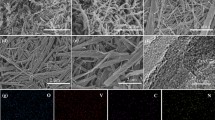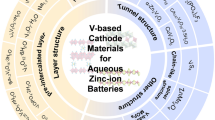Abstract
Aqueous zinc ion batteries (AZIBs) attract increasing attention due to their low cost, safety, environmental protection, and potential application in stationary energy storage. However, the realization of high discharge voltage, high cycle stability, and high energy density is still the main challenge. Herein, we report a highly stable V2O3 sample synthesized by the reduction method of boron with high-temperature molten salt. In this method, molten salt was used as solvent to react between solid and liquid, and the ion velocity is significantly accelerated; the reaction temperature and time are effectively reduced. The electrochemical performance results show that V2O3 can provide a maximum discharge specific capacity of 207 mAh g−1 at 0.1 A g−1. The V2O3 electrode exhibits a high specific discharge capacity of 110 mAh g−1 after 2500 cycles at 3 A g−1; the capacity retention rate is 82.1%. Its electrochemical performance is obviously better than that of commercial V2O3. The electrochemical kinetic studies show that V2O3 electrode has a fast diffusion coefficient of zinc ions. This work provides an effective strategy to enhance the energy density and cycling stability of aqueous zinc ion-based batteries.








Similar content being viewed by others
References
Konarov A, Voronina N, Jo JH et al (2018) Present and future perspective on electrode materials for rechargeable zinc-ion batteries[J]. ACS Energy Lett 3:2620–2640
Ming F, Liang H, Lei Y et al (2018) Alshareef, Layered MgxV2O5·nH2O as cathode material for high-performance aqueous zinc ion batteries[J]. ACS Energy Lett 3:2602–2609
Goodenough JB, Kim Y (2010) Challenges for rechargeable Li batteries[J]. Chem Mater 22:587–603
Song M, Tan H, Chao DL, Fan HJ (2018) Recent advances in zn-ion batteries[J]. Adv Func Mater 28(41):1802564
Chen LL, Yang ZH, Huang Y et al (2019) Monoclinic VO2(D) hollow nanospheres with super-long cycle life for aqueous zinc ion batteries[J]. Nanoscale 11(27):13032–13039
Liu J, Hu JP, Deng Q et al (2015) Aqueous rechargeable batteries for large-scale energy storage[J]. Isr J Chem 55:521–536
Li HP, Xu ZX, Yang J et al (2020) Polymer electrolytes for rechargeable lithium metal batteries[J]. SUT J Math 4(11):5469–5487
Gupta T, Kim A, Phadke S et al (2016) Improving the cycle life of a high-rate, high-potential aqueous dual-ion battery using hyper-dendritic zinc and copper hexacyanoferrate[J]. J Power Sources 305(15):22–29
Alfaruqi MH, Islam S, Mathew V et al (2017) Ambient redox synthesis of vanadium-doped manganese dioxide nanoparticles and their enhanced zinc storage properties[J]. Appl Surf Sci 404:435–442
Wei T, Li Q, Yang G et al (2018) High-rate and durable aqueous zinc ion battery using dendritic V10O24·12H2O cathode material with large interlamellar spacing[J]. Electrochim Acta 287:60–67
Zhang N, Dong Y, Jia M et al (2018) Rechargeable aqueous Zn-V2O5 battery with high energy density and long cycle life[J]. ACS Energy Lett 3:1366–1372
Chen HZ, Rong Y, Yang ZH et al (2021) V2O3@amorphous carbon as a cathode of zinc ion batteries with high stability and long cycling life[J]. Ind Eng Chem Res 60(4):1517–1525
He P, Zhang GB, Liao XB et al (2018) Sodium ion stabilized vanadium oxide nanowire cathode for high-performance zinc-ion batteries[J]. Adv Energy Mater 8(10):1702463
Y. S. Cai, F. Liu, Z. G. Luo, et al. Pilotaxitic Na1.1V3O7.9 nanoribbons/graphene as high-performance sodium ion battery and aqueous zinc ion battery cathode-ScienceDirect. Energy Storage Materials, 2018, 13: 168–174.
Fan L, Li Z, Kang W et al (2020) Highly stable aqueous rechargeable Zn-ion battery: the synergistic effect between NaV6O15 and V2O5 in skin-core heterostructured nanowires cathode[J]. J Energy Chem 55:25–33
Liu P, Zhu K, Gao Y et al (2017) Recent progress in the applications of vanadium-based oxides on energy storage: from low-dimensional nanomaterials synthesis to 3D micro/nano-structures and free-standing electrodes fabrication[J]. Adv Energy Mater 7:1700547
Hartung S, Bucher N, Franklin JB et al (2016) Mechanism of Na+ insertion in alkali vanadates and its influence on battery performance[J]. Adv Energy Mater 6:1502336
Hu P, Yan MY, Zhu T et al (2017) Zn/V2O5 aqueous hybrid-ion battery with high voltage platform and long cycle life [J]. ACS Appl Mater Interfaces 9(49):42717–42722
Wan F, Niu ZQ (2019) Design strategies for vanadium-based aqueous zinc-ion batteries[J]. Angew Chem Int Ed 58(46):16358–16367
Tian M, Liu CF, Zheng JQ et al (2020) Structural engineering of hydrated vanadium oxide cathode by K+ incorporation for high-capacity and long-cycling aqueous zinc ion batteries[J]. Energy Storage Mater 29:9–16
Yang YQ, Tang Y, Fang GZ et al (2018) Li+ intercalated V2O5·nH2O with enlarged layer spacing and fast ion diffusion as an aqueous zinc-ion battery cathode[J]. Energy Environ Sci 11(11):3157–3162
Deng W, Zhou Z, Li Y et al (2020) High-capacity layered magnesium vanadate with concentrated gel electrolyte toward high-performance and wide-temperature zinc-ion battery[J]. ACS Nano 14(11):15776–15785
Kundu D, Adams BD, Duffort V et al (2016) A high-capacity and long-life aqueous rechargeable zinc battery using a metal oxide intercalation cathode[J]. Nat Energy 1(10):16119
Lan BX, Peng Z, Chen LN et al.(2019) Metallic silver doped vanadium pentoxide cathode for aqueous rechargeable zinc ion batteries[J]. Journal of Alloys and Compounds 7879–16
Yan M, He P, Chen Y et al (2018) Water-lubricated intercalation in V2O5·nH2O for high-capacity and high rate aqueous rechargeable zinc batteries[J]. Adv Mater 30(1):1703725
Gou WW, Zhong KX, Wang YP et al. (2019) Yolk-shell structured V2O3 microspheres wrapped in N, S co-doped carbon as pea-pod nanofibers for high-capacity lithium ion batteries[J]. Chemical Engineering Journal 374545–553.
Han CH, Li F, Liu JH et al (2018) Facile template-free synthesis of uniform carbon-confined V2O3 hollow spheres for stable and fast lithium storage[J]. Journal of Materials Chemistry A 6(15):6220–6224
Kong LJ, Zhong M, Liu YY et al. (2018) Ultra-small V2O3 embedded N-doped porous carbon nanorods with superior cycle stability for sodium-ion capacitors[J]. Journal of power sources 40537–44.
Li H, Balaya P, Maier J (2004) Li-storage via heterogeneous reaction in selected binary metal fluorides and oxides[J]. J Electrochem Soc 151(11):A1878–A1885
Ding YC, Peng YQ, Chen SH et al (2019) Hierarchical porous metallic V2O3@C for advanced aqueous zinc-ion batteries[J]. ACS Appl Mater Interfaces 11(47):44109–44117
Wei T, Li Q, Yang G et al (2018) An electrochemically induced bilayered structure facilitates long-life zinc storage of vanadium dioxide [J]. Journal of Materials Chemistry A 6(17):8006–8012
Chen LL, Yang ZH, Cui F et al. (2020) Enhanced rate and cycling performances of hollow V2O5 nanospheres for aqueous zinc ion battery cathode[J]. Applied Surface Science 507145137
Chen HZ, Chen LL, Meng JL et al. (2020) Synergistic effects in V3O7/V2O5 composite material for high capacity and long cycling life aqueous rechargeable zinc ion batteries[J]. Journal of Power Sources 474228569
Qin HG, Chen LL, Wang LM et al. (2019) V2O5 hollow spheres as high rate and long life cathode for aqueous rechargeable zinc ion batteries[J]. Electrochimica Acta 306307–316.
Tang W, Lan BX, Tang C et al (2020) Urchin-like spinel MgV2O4 as a cathode material for aqueous zinc-ion batteries[J]. ACS sustainable chemistry & engineering 8(9):3681–3688
Xu DM, Wang HW, Li FY et al (2019) Conformal conducting polymer shells on V2O5 nanosheet arrays as a high-rate and stable zinc-ion battery cathode[J]. Adv Mater Interfaces 6(2):1801506
Wang X, Li Q, Zhang L et al (2018) Caging Nb2O5 nanowires in PECVD-derived graphene capsules toward bendable sodium-ion hybrid supercapacitors [J]. Adv Mater 30(26):1800963
Le Z, Liu F, Nie P et al (2017) Pseudocapacitive sodium storage in mesoporous single-crystal-like TiO2-graphene nanocomposite enables high-performance sodium-ion capacitors [J]. ACS Nano 11(3):2952–2960
Fang GZ, Zhu CY, Chen MH et al. (2019) Suppressing manganese dissolution in potassium manganate with rich oxygen defects engaged high-energy-density and durable aqueous zinc-ion battery[J]. Advanced Functional Materials 1808375.
Ding JW, Du ZG, Gu LQ et al (2018) Ultrafast Zn2+ intercalation and deintercalation in vanadium dioxide[J]. Adv Mater 30(26):1800762
Chen LL, Yang ZH, Wu J et al. (2020) Energy storage performance and mechanism of the novel copper pyrovanadate Cu3V2O7(OH)2·2H2O cathode for aqueous zinc ion batteries[J]. Electrochimica Acta 330, 135347
Acknowledgements
We thank the Natural Science Foundation of Hunan Provincial Science and Technology Plan Project (No. 2017TP1001) for giving financial support to this study.
Author information
Authors and Affiliations
Corresponding author
Additional information
Publisher's note
Springer Nature remains neutral with regard to jurisdictional claims in published maps and institutional affiliations.
Rights and permissions
About this article
Cite this article
Deng, L., Chen, H., Wu, J. et al. V2O3 as cathode of zinc ion battery with high stability and long cycling life. Ionics 27, 3393–3402 (2021). https://doi.org/10.1007/s11581-021-04121-x
Received:
Revised:
Accepted:
Published:
Issue Date:
DOI: https://doi.org/10.1007/s11581-021-04121-x




